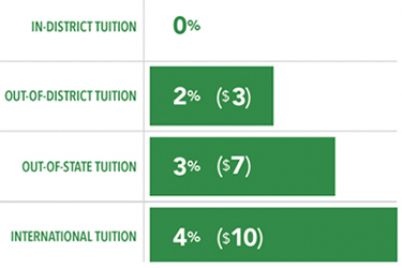
Dr. Mona Hanna-Attisha visited WCC for Women’s History Month and gave a talk in the Towsley Auditorium on March 6. Sara Faraj | Washtenaw Voice
By Lilly Kujawski
Editor
WCC celebrated the beginning of Women’s History Month on March 6 with a visit from Dr. Mona Hanna-Attisha, a pediatrician at Hurley Medical Center in Flint and author whose research helped reveal the presence of lead in Flint’s water system in 2015.
The event was hosted at Towsley Auditorium, where Hanna-Attisha began with some celebratory remarks to honor Women’s History Month.
“We’re in this incredible moment right now in Michigan,” Hanna-Attisha said. “We have more women in leadership roles than we’ve ever had, from the governor, to the secretary of state, to the attorney general, a Michigan supreme court chief justice, and U.S. senator.”
“Finally, girls all over the state can look in the mirror and see themselves as leaders, and also as scientists, and engineers, and writers, and doctors, and whatever else they want to be,” she added. “We still have a long way to go, I’m not saying our work, in terms of equality, is done; we have a lot more glass ceilings to break, a lot more doors to bust open, especially board rooms.”
“We cannot forget about the amazing women who have paved the way for so many us to be able to prosper,” Hanna-Attisha said.
She also paid tribute to two women she considers role models: Genora Johnson Dollinger, often referred to as the “Joan of Arc of Labor,” who organized the Women’s Emergency Brigade during the 1937 General Motors sit down strikes in Flint, and Alice Hamilton, the first woman to be appointed as a faculty member at Harvard Medical School, whose research laid the groundwork for modern understanding of lead toxicology and testing. According to Hanna-Attisha, both women were seen as “hysterical” for their activist work.
In 2014, while the city was under emergency management, a decision was made by Michigan government officials to cut costs in Flint by rerouting its drinking water supply from the Great Lakes to the Flint River, Hanna-Attisha said.
“Just a few months after this water switch… General Motors, which still operates in Flint, noticed that this water was corroding engine parts,” she said. “Think about that: the water was corroding engine parts and GM was allowed to go back to Great Lakes water, yet the people of Flint throughout this time were literally told to ‘relax.’”
In 2015, Hanna-Attisha found out from a friend, an EPA employee at the time and drinking water expert, that the water in Flint wasn’t being with a federally-mandated corrosion control ingredient, which was causing the lead pipes to corrode into the water.
According to Hanna-Attisha, there is lead in nearly all of the plumbing in the United States. Lead service lines weren’t banned until 1986 and the use of lead in fixtures and faucets wasn’t banned until 2014, Hanna-Attisha said.
“When a pediatrician hears the word ‘lead’, when anybody in public health hears the word ‘lead,’ we really kind of freak out and Alice Hamilton taught us that,” Hanna-Attisha said. “We’ve known for centuries what lead does, it’s probably the most well-studied neurotoxin known to man.”
“My life changed when I heard about the possibility of lead in the water,” Hanna-Attisha said. “As a pediatrician, I have literally taken an oath to protect children.”
Immediately after she found out the water wasn’t being treated properly, Hanna-Attisha, who was working at Hurley Children’s Hospital at the time, began conducting research to find out if the lead was in the bodies of Flint children by testing their blood levels. Her research found that after the water switch, the percentage of children with elevated lead levels had doubled, but there was no change in the levels of children outside of the Flint area.
When Hanna-Attisha discovered these elevated lead levels and their connection to the Flint water system, she decided to take swift action—she brought the data to the public right away, without peer reviews or prior publication.
“The peer review process is really important for those of us in academics,” Hanna-Attisha said. “But that takes a really long time and our kids in Flint literally did not have another day.”
After she revealed her data, Hanna-Attisha said she received immediate pushback from government officials, who attempted to discredit her.
“They said that I was an unfortunate researcher and they said that I was causing mere hysteria,” said Hanna-Attisha, which she compared as a similar response to that received by Hamilton and Dollinger for their work.
Hanna-Attisha said through persistence, teamwork and science, she and her colleagues “spoke truth to power” and exposed the issue.
“The story of Flint is not isolated, it is a story of a deeper crisis that really we are facing right now as a nation,” said Hanna-Attisha. “The very people responsible for keeping us safe and healthy care more about power and money than they do about us.”
“Lady Liberty’s arms aren’t as open as they used to be,” said Hanna-Attisha, who emigrated to the United States from Iraq as a child. “The ‘American Dream’ is also corroded.”
Hanna-Attisha said the community has responded to the crisis with a holistic approach to helping families and communities heal and thrive. She said it is key that the residents of Flint dictate their own recovery.
“During that loss of democracy, those voices were not being heard,” she said. “Having a role in the recovery and self-determination is a critical part of healing.”
“In this city known for building really, really strong cars, now we’re committed to building really strong children,” Hanna-Attisha said.
Many audience members left the talk feeling inspired and empowered by Hanna-Attisha’s story.
Fadwa Ashur, 21, a WTMC graduate and current Eastern Michigan University student, said she admired Hanna-Attisha willingness to fight for others where she saw suffering, regardless of the repercusions.
“I think it’s good to see an Arab American woman making massive strides in helping people the government won’t help,” said Zaynab Elkolaly, 17, a WTMC student.



One Reply to “Flint’s Dr. Mona kicks off Women’s History Month on campus”
Comments are closed.